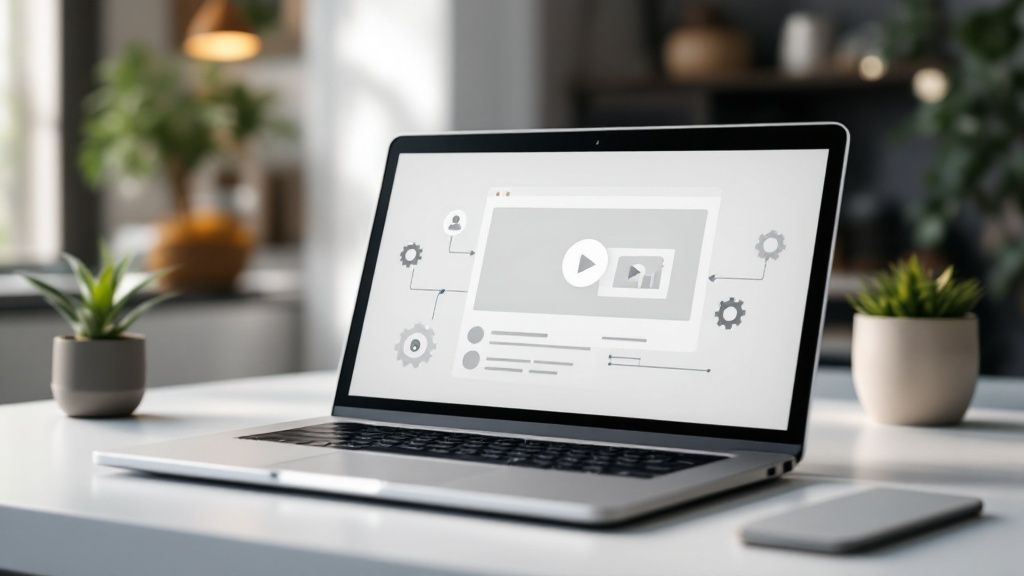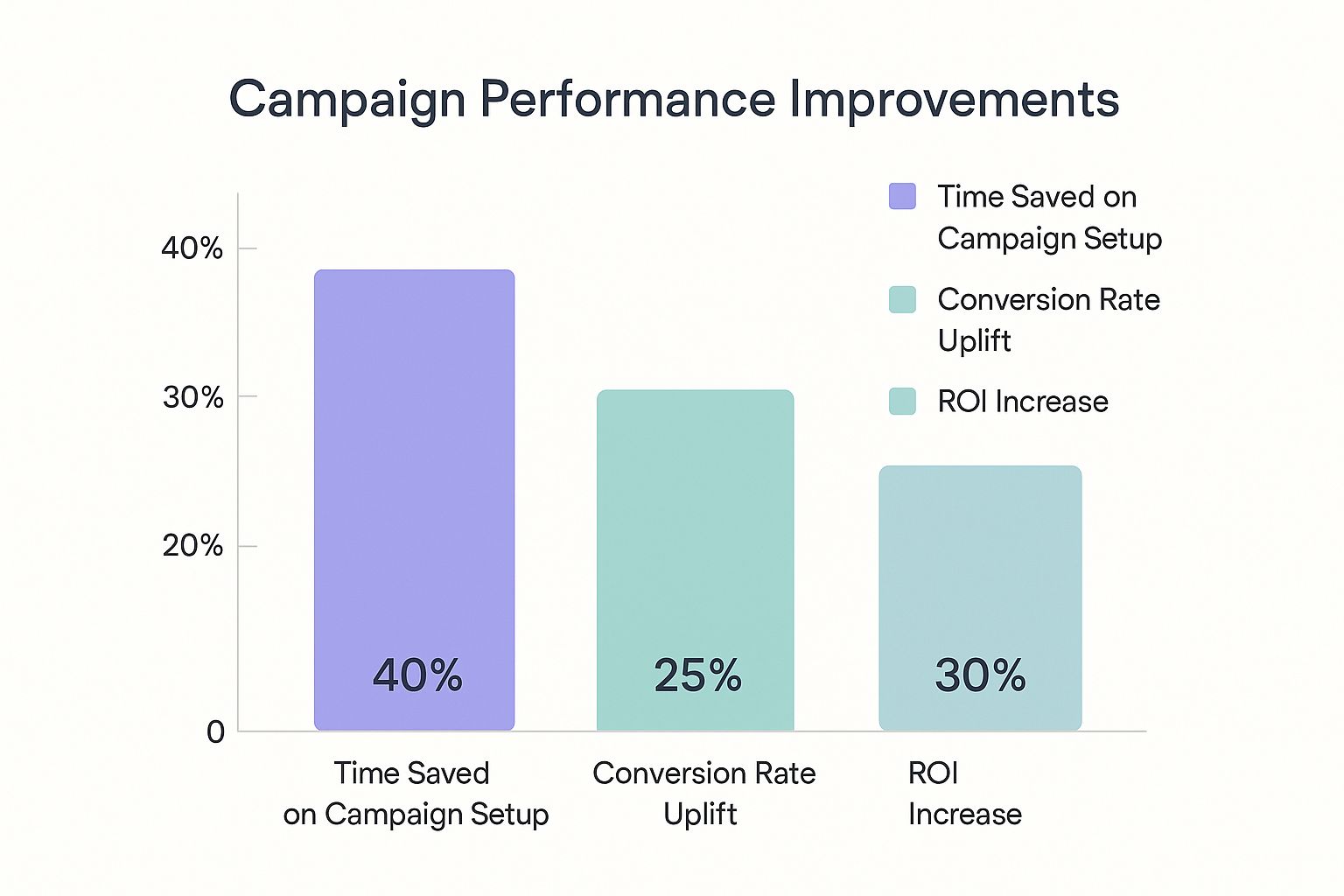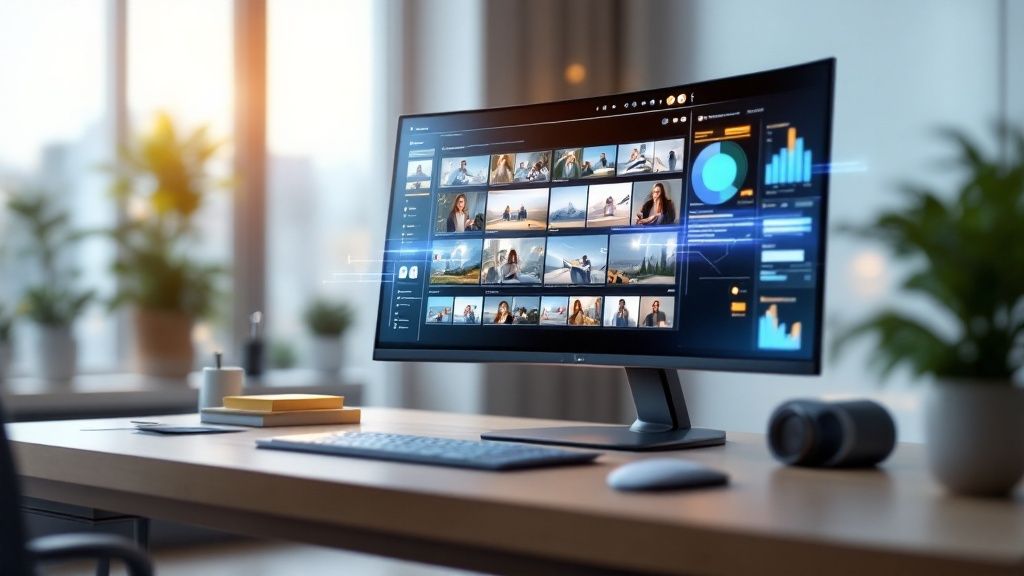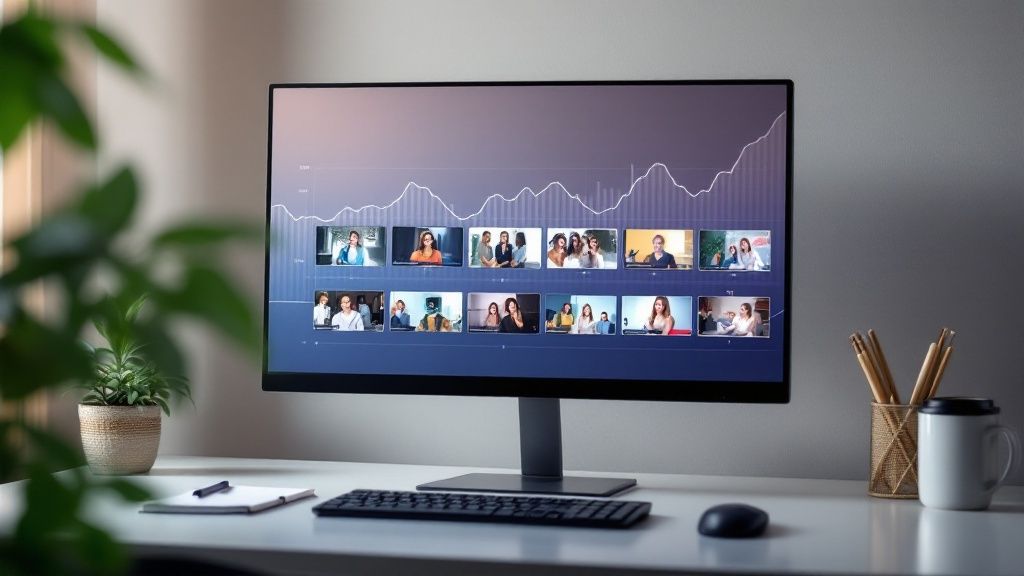The Evolution of Video Ad Automation

Creating video ads was once a costly and complex process, often excluding smaller businesses. The need for large budgets and specialized teams created a barrier to entry. But the rise of video ad automation has changed everything, making video marketing accessible to businesses of all sizes.
This evolution is driven by several key technological advancements, putting the power of video into the hands of every business.
Key Advancements Driving Video Ad Automation
AI-Powered Creative Tools: These tools dramatically reduce production time and costs by automating tasks like video editing, scriptwriting, and voiceover generation. Marketers can now quickly produce multiple ad variations, optimized for various platforms and audiences. Imagine transforming existing long-form video content into short, engaging clips for platforms like TikTok or Instagram Reels automatically. AI makes this possible, significantly extending your content’s reach.
Automated Targeting Capabilities: Reaching the right audience with the right message at the right time is paramount. AI and machine learning powered targeting analyzes massive datasets to pinpoint ideal customer profiles and predict viewer engagement. This ensures efficient ad spend and maximizes your return on investment (ROI).
Programmatic Platforms: Streamlining the ad buying process is essential for efficiency. Programmatic platforms automate the buying and selling of ad space using real-time bidding to secure optimal placements at the best prices. This frees up marketers to concentrate on strategic planning and creative development rather than manual ad buys.
These combined advancements eliminate previous bottlenecks in video ad production. Now, even small businesses can harness the power of video to connect with their audience, share compelling stories, and drive conversions. This isn’t just a trend; it's a revolution.
The numbers speak for themselves. In 2025, video advertising automation adoption reached record highs, with 89% of businesses using video as a marketing tool. Even more impressively, 93% of marketers report a positive ROI from their video marketing investments. Find more detailed statistics here. This growth showcases the effectiveness and accessibility of video ad automation in today's marketing landscape. Want to learn more about creating cutting-edge content? Check out our guide on creating ultra-realistic UGC videos with AI influencers.
Want to stay ahead of the curve? Learn How to master AI-generated UGC videos. These technologies empower brands to compete effectively in a video-driven world. Early adoption provides a significant competitive advantage. As video continues to dominate online content, automation is no longer optional; it's a necessity.
Essential Components That Drive Results
Video ad automation is the key to unlocking truly measurable results, powered by a sophisticated synergy of technologies working behind the scenes. Let's delve into the core components driving these successful automated campaigns, exploring the tangible value they offer.
Core Technologies of Video Ad Automation
Creative Management Platforms: These platforms act as a centralized hub for your video assets, streamlining organization, version control, and team collaboration. Imagine effortlessly managing all video variations, across diverse platforms and aspect ratios, all within a single, accessible location. This not only saves valuable time but also ensures brand consistency throughout your campaigns. Sprello, for example, empowers users to repurpose existing footage into various iterations, optimized for different social media platforms.
Dynamic Optimization Tools: Dynamic optimization analyzes real-time campaign data and automatically fine-tunes your bidding strategies, targeting parameters, and even creative elements to maximize ROI. This constant learning and improvement allows your campaigns to adapt to audience behavior and market trends without requiring manual adjustments.
AI-Powered Creative Tools: AI plays a critical role in automating the creative process itself. These tools can generate scripts, edit videos, and even create voiceovers, significantly reducing production time and costs. This also enables the rapid creation of numerous ad variations tailored to specific audience segments or platforms.
Programmatic Advertising Platforms: Programmatic platforms automate the complexities of ad buying. Their algorithms bid on ad space in real time, securing prime placements for your videos at the most competitive prices. This removes the need for manual negotiations and insertion orders, allowing your team to concentrate on strategic initiatives and creative development. The evolution of video ad automation mirrors advancements in other automation areas, such as the evolution of Text Message Automations Platforms.
To further illustrate these essential components and their respective roles, let's take a closer look at the following table. This table outlines how each component contributes to a seamless and impactful video marketing workflow.
| Component | Primary Function | Business Impact | Implementation Complexity |
|---|---|---|---|
| Creative Management Platforms | Centralized storage, organization, and version control of video assets | Streamlined workflows, improved brand consistency, reduced time spent on asset management | Low to Moderate |
| Dynamic Optimization Tools | Real-time analysis and adjustment of campaign parameters (bidding, targeting, creative) | Increased ROI, improved campaign performance, reduced manual effort | Moderate to High |
| AI-Powered Creative Tools | Automated script generation, video editing, and voiceover creation | Reduced production time and costs, rapid creation of ad variations | Moderate |
| Programmatic Advertising Platforms | Automated ad buying and placement | Optimized ad spend, improved reach and targeting, freed-up resources for strategic planning | Moderate to High |
As you can see, each component plays a vital role in maximizing the effectiveness and efficiency of your video ad campaigns. By integrating these technologies, businesses can achieve significant improvements in ROI and overall marketing performance.
Measuring the Impact of Automation

The infographic above visually represents the significant impact of video ad automation. It highlights the time saved on campaign setup, conversion rate uplift, and ROI increase. Automating your video ads can lead to a 40% reduction in campaign setup time, a 25% increase in conversion rates, and a 30% boost in ROI. These remarkable gains underscore the power and efficiency of integrating automation into your video advertising strategy.
Balancing Automation and Human Creativity
While automation offers substantial benefits, finding the right balance between automation and human creativity is paramount. Tasks like bid optimization and A/B testing are ideal for automation. However, crucial aspects such as developing core brand messaging and crafting compelling narratives still require the human touch.
This balance is essential for preserving brand authenticity and ensuring your videos resonate deeply with your target audience. Think of automation as a tool that empowers your creative team, not replaces it. By automating repetitive and time-consuming tasks, your team is free to focus on strategic thinking, creative innovation, and building genuine connections with viewers. This collaborative approach ensures your video ads are not only efficient and effective but also maintain the heart and soul of your brand. For instance, while AI can assist with scriptwriting, human oversight is essential to refine the narrative and ensure it aligns with your brand's values. This combined approach produces videos that are both data-driven and emotionally resonant, ultimately driving optimal performance and cultivating brand loyalty.
Mobile-First Success With Video Ad Automation

Mobile has changed how we watch videos. This creates both challenges and opportunities for video ad automation. Smart brands aren't just reusing desktop ads; they're tailoring video content for mobile.
Understanding the Mobile Viewer
Mobile viewers are different. They're often on the go, have shorter attention spans, and watch videos in short bursts. Capturing their attention requires concise, visually compelling ads. Think of a mobile screen as a small stage with a fleeting audience. Your ad needs to make a big impact.
Sound is a key factor. Most mobile users watch videos with the sound off, requiring strong visuals and clear subtitles. Also, varying screen sizes and aspect ratios require automated adjustments for optimal viewing. Video ad automation dynamically adapts to these variations, ensuring your message is always clear.
Mobile viewers are also more likely to interact. Features like polls, quizzes, and shoppable elements can boost engagement. Integrating with other marketing automation, such as automated text messages, is a vital part of this strategy.
Optimizing for Mobile Success
Technical specs are crucial for optimizing mobile video ads. Here are some key considerations:
- File Size: Smaller files load faster, grabbing attention before users scroll past.
- Video Format: Formats like MP4 and MOV ensure compatibility.
- Resolution: Optimizing for different resolutions ensures clear visuals.
- Aspect Ratio: Automation tools can automatically adjust aspect ratios (like 9:16 for stories) for different platforms, maximizing screen space and engagement.
Video ad automation goes beyond these basics. It dynamically optimizes campaigns based on network connectivity, device, and user behavior. This delivers personalized ads, ensuring the right message reaches the right audience at the right time, adapting to mobile's limitations. This is a huge advantage over traditional video production.
Think about user behavior. Video ad automation excels on mobile. In 2025, 76% of mobile video ads will autoplay with sound off, compared to 49% on desktops. This demands captivating visuals and subtitles. Mobile viewers are also 54% more likely to share, boosting organic reach. These stats show automation's power on mobile. Learn more about these trends.
From Production to Performance
Video ad automation streamlines production and delivery for mobile. Automation tools can automatically generate variations optimized for different platforms, allowing marketers to test multiple creative concepts quickly. Automation also provides data and analytics on viewer engagement, helping marketers refine their strategies.
By understanding mobile and using automation, brands can unlock video advertising's full potential on mobile, turning short attention spans into lasting customer relationships. This mobile-first approach is no longer optional—it’s essential for success.
Maximizing ROI Through Smart Budget Allocation
Let's talk about the financial side of video ad automation. Knowing how much to invest in this technology is critical. This section offers a practical guide to planning, allocating, and measuring the ROI of your automated video ad campaigns.
Planning Your Video Ad Automation Budget
Effective budget allocation starts with understanding your business goals. What are you aiming for? Rapid growth? Increased brand awareness? Higher conversion rates? Each objective demands a different budgetary strategy. For instance, brand awareness campaigns may prioritize reach, while conversion-focused campaigns might emphasize targeted ad placements.
Next, consider your business size and resources. Smaller businesses might begin with a modest budget, focusing on specific platforms and expanding as ROI improves. Larger enterprises can invest more broadly, using automation to manage more complex, multi-channel campaigns. Think of it like building a house: start with a solid foundation and add rooms as your budget expands.
Allocation Strategies for Maximum Impact
Once your overall budget is set, strategic allocation is key. Distribute resources across the different stages of video ad automation. Consider these crucial areas:
- Software and Tools: Invest in robust video ad automation platforms like Sprello. These platforms offer essential features for creative development, campaign management, and performance analysis.
- Creative Development: Even with automation, allocate funds for creating high-quality assets. Compelling visuals and engaging stories are still paramount.
- Media Buying: Decide how much of your budget will go towards purchasing ad space across different platforms. Many video ad automation platforms integrate with programmatic buying tools, streamlining your ad spend.
- Testing and Optimization: Set aside a portion of your budget for A/B testing. Experiment with creative variations, targeting parameters, and bidding strategies. This iterative process drives continuous improvement and maximizes ROI over time.
Measuring and Communicating ROI
Measuring ROI in video ad automation requires understanding the right metrics. Click-through rates (CTR) and conversion rates provide immediate performance insights. However, brand lift and customer lifetime value (CLTV) are vital for long-term evaluation. A video ad might not generate an immediate sale, but it could significantly boost brand awareness, influencing future purchases.
Communicating results to stakeholders unfamiliar with video marketing requires clear, concise reporting. Focus on translating video-specific KPIs into business outcomes. Show how increased brand awareness leads to potential leads and ultimately, sales. Use visuals like charts and graphs to effectively present complex data.
Digital video ad spend is predicted to reach nearly 60% of total TV and video advertising spending in the U.S. by 2025, a significant jump from just 29% in 2020. This growth is driven by video ad automation technologies that enable scalable, targeted campaigns. Learn more about this trend. This reinforces the growing importance of incorporating video ad automation into your marketing strategy.
Budget Templates and Strategies
Developing budget templates for different business models can simplify planning. Consider creating templates for:
- E-commerce Businesses: Focus on metrics like return on ad spend (ROAS) and cost per acquisition (CPA).
- SaaS Companies: Prioritize metrics like lead generation and customer churn rate.
- Brand Awareness Campaigns: Track metrics like reach, impressions, and brand mentions.
These templates provide a framework for strategic resource allocation. Adapt these templates as your business and goals evolve. Smart budget allocation in video ad automation is an ongoing process of planning, analyzing, and refining.
Personalization at Scale: Beyond Basic Targeting
The real strength of automated video ads isn't just about hitting the right demographics. It's about crafting personalized experiences that truly resonate with individual viewers. Think thousands of video variations, each speaking directly to a specific audience segment. This is the future of video advertising, and it's within your reach.
Modular Creative: The Building Blocks of Personalization
Imagine the flexibility of LEGOs. Each brick is a standalone element – a visual, a sound, a piece of dialogue. Modular creative in video advertising works the same way. It's about building a library of individual components that can be combined in countless ways. This allows video automation platforms to generate highly targeted variations without starting from scratch every time.
Imagine different opening scenes tailored to viewers' interests, leading into a core product message, and finishing with a location-specific call to action. This is the power of modular creative, offering the ability to personalize at scale.
Data Frameworks: Fueling Personalized Experiences
Personalized video ads thrive on data. We're talking about more than just basic demographics. Advanced data frameworks incorporate a richer picture of your audience:
- Behavioral Data: Website visits, product browsing history, and past purchases tell a story.
- Contextual Data: What are they reading right now? What’s trending in their area? Context adds another layer of relevance.
- Psychographic Data: Values, motivations, and lifestyle choices provide powerful insights into what makes your viewers tick.
This data fuels the automation, ensuring the right creative elements are selected for each individual, leading to genuinely relevant ads that drive higher engagement and increased conversions. Want to learn more about AI-generated content? Check out this article: How to master AI-generated UGC videos.
Testing and Optimization: Continuous Improvement
Data-driven decision making is key. Even with sophisticated data frameworks, continuous testing is essential. A/B testing different variations allows you to pinpoint which personalized elements resonate most. Perhaps showcasing specific product benefits or tailoring calls to action based on past purchases yields significantly better results. This iterative process helps you refine your approach and maximize your ROI.
Balancing Customization and Efficiency
One of the biggest hurdles in personalized video ad automation is balancing customization and production efficiency. Creating thousands of unique videos can be a drain on resources. This is where modular creative shines, providing high levels of personalization without exorbitant costs.
AI-powered tools can further streamline production by automating key tasks like video editing, voiceovers, and asset management. This empowers even smaller teams to manage complex personalized campaigns efficiently. Sprello is one example of a company offering these types of tools.
Industry Examples and Best Practices
Across diverse industries, businesses are already leveraging personalized video ad automation. E-commerce brands showcase product recommendations based on browsing history. Travel companies tailor ads to highlight destinations aligned with users' travel preferences. These are just a few examples of how personalization is transforming advertising. Look to industry leaders for inspiration and to uncover valuable insights for your own video automation strategy.
To illustrate the impact of personalization across various sectors, consider the following table:
Personalization Performance by Industry
This table presents key metrics showing how automated personalized video ads perform compared to generic video ads across different industry sectors.
| Industry | Engagement Lift | Conversion Rate Improvement | Cost Per Acquisition Reduction | Implementation Complexity |
|---|---|---|---|---|
| E-commerce | +35% | +20% | -15% | Medium |
| Travel & Hospitality | +28% | +18% | -12% | Medium |
| Financial Services | +22% | +15% | -10% | High |
| Healthcare | +18% | +12% | -8% | High |
As the table clearly demonstrates, personalized video ads consistently outperform generic ads across various industries, delivering significant improvements in engagement, conversion rates, and cost efficiency. While implementation complexity varies depending on the sector, the potential rewards are compelling. Investing in personalization can provide a substantial competitive advantage in today's dynamic market.
Future-Proofing Your Video Ad Automation Strategy

Video ad automation isn't a set-it-and-forget-it solution. It's a dynamic field that demands constant adaptation. This section explores emerging trends set to reshape video advertising, empowering you to prepare for the future. By understanding these advancements, you can position your brand to seize opportunities that others may overlook.
Generative AI: The Creative Revolution
Generative AI is revolutionizing video creation. Imagine software automatically generating video variations, tailored for different platforms and audiences. This technology transcends basic editing; it creates visuals, writes scripts, and even generates voiceovers, significantly reducing production time and costs. This empowers marketers to experiment with diverse creative concepts quickly and efficiently.
For example, consider creating a video ad for both YouTube and TikTok. Generative AI can automatically adjust the aspect ratio, pacing, and messaging, optimizing for each platform, creating two distinct yet effective versions from a single source.
Predictive Analytics: Optimizing for the Future
Predictive analytics elevates data-driven optimization. By analyzing historical campaign data and current market trends, these tools can forecast future performance and automatically adjust bidding strategies, targeting parameters, and creative elements. This proactive approach maximizes ROI by continuously adapting to changing market dynamics.
This means anticipating future trends instead of reacting to past performance, ensuring your campaigns stay ahead of the competition. It's like a chess grandmaster thinking several moves ahead, anticipating their opponent’s strategy.
Interactive and Shoppable Video: Engaging the Modern Consumer
Interactive and shoppable video ads are transforming consumer engagement. Imagine clicking directly within a video to purchase a product or learn more about a service. These interactive elements create a seamless path to conversion, increasing engagement and driving sales.
Consider the potential of personalized product recommendations within a video ad, based on viewer history. This level of targeting creates a highly personalized and engaging experience. You might be interested in: How to master AI-generated UGC videos and stay up-to-date on the latest innovations.
Navigating the Privacy Landscape
Data privacy is paramount. As regulations evolve, video ad automation must adapt. Future-proof strategies will prioritize privacy while still delivering personalized experiences. This requires focusing on responsible data collection and transparent usage practices.
For instance, brands may shift towards contextual targeting, focusing on the content a viewer is currently consuming rather than relying on extensive personal data. This approach maintains relevance while respecting user privacy.
Emerging Platforms and Technologies
New platforms and technologies constantly emerge. Staying informed about these developments is crucial for future success. This involves exploring new social media platforms, experimenting with augmented reality (AR) and virtual reality (VR), and understanding the potential of blockchain technology for transparent ad tracking.
This constant evolution demands a proactive approach. Brands must experiment, adapt, and invest in continuous learning to stay ahead.
Preparing Your Team for the Future
Adapting to these changes requires a skilled workforce. Invest in training and development that equips your team with the expertise to manage advanced technologies. This includes fostering continuous learning and encouraging experimentation with new tools and techniques.
By embracing these emerging trends and investing in your team, you can future-proof your video ad automation strategy and position your brand for long-term success. This proactive approach ensures you’re not just keeping up with change, but driving it.
Implementation Blueprint: From Strategy to Execution
Ready to supercharge your video marketing with video ad automation? This section offers a practical, step-by-step guide designed to integrate seamlessly with your current setup. We'll cover how to analyze your existing workflows, pinpoint key areas ripe for automation, select the perfect tech partners, and navigate the organizational changes that come with adopting new technology.
Auditing Your Current Video Ad Workflows
The first step towards successful implementation is understanding your current processes inside and out. This means mapping every single stage of your video ad creation and deployment:
- Content Ideation and Planning: How are video concepts generated and greenlit?
- Production: What steps are involved in filming, editing, and post-production?
- Distribution: How are videos distributed across various platforms?
- Performance Analysis: What metrics are you tracking, and how are those insights used to optimize future campaigns?
This audit will uncover bottlenecks, inefficiencies, and opportunities for significant improvement. For example, if your team is bogged down with manual video editing, automating this process can free them up for more strategic work.
Identifying High-Impact Automation Opportunities
Not all processes are created equal when it comes to automation. Focus on areas with the biggest potential return on investment:
- Repetitive Tasks: Video editing, resizing for different platforms, and ad scheduling are perfect candidates.
- Data-Driven Optimization: Automating bid management, targeting adjustments, and A/B testing can dramatically improve campaign performance.
- Personalization at Scale: Automation enables the creation and delivery of thousands of ad variations, personalizing messaging for individual audiences.
Prioritizing these high-impact areas will deliver quick wins while laying the groundwork for long-term success.
Selecting the Right Technology Partners
Choosing the right video ad automation platform is critical. Consider these key factors:
- Features and Capabilities: Does the platform offer the specific features you need, such as AI-powered creative tools, dynamic optimization, and programmatic buying integration?
- Ease of Use: Is the platform intuitive and easy to integrate with your current setup?
- Scalability: Can the platform handle your present and future needs as your business expands?
- Pricing: Does the pricing model fit your budget and projected ROI? Platforms like Sprello offer various pricing tiers to suit businesses of all sizes.
Thoroughly research different vendors, compare features, and don't hesitate to request demos to see how each platform addresses your specific needs.
Managing Organizational Change
Implementing video ad automation often requires organizational adjustments. This includes:
- Building Cross-Functional Teams: Assemble creative, marketing, and data teams to collaborate effectively and maximize the benefits of automation.
- Developing Governance Frameworks: Establish clear guidelines and processes to ensure brand consistency across all automated campaigns.
- Creating Training Programs: Equip your team with the necessary skills and knowledge to confidently use new automation systems.
Addressing these organizational aspects will smooth the transition and foster a data-driven culture.
Implementation Timelines and Milestones
Create realistic timelines for implementing video ad automation, breaking the process down into manageable phases:
- Phase 1: Pilot Project: Begin with a small-scale pilot project to test automation tools and refine your processes.
- Phase 2: Expand to Key Campaigns: Gradually expand automation to your most important campaigns based on the success of the pilot.
- Phase 3: Full Implementation: Implement automation across all video ad campaigns and continuously optimize performance.
Setting clear milestones and diligently tracking progress will ensure your automation journey delivers measurable results efficiently. Identifying key performance indicators (KPIs) and monitoring them closely will allow you to track progress and make data-driven adjustments. These KPIs might include click-through rates, conversion rates, and cost per acquisition. Regularly reviewing performance against these milestones is crucial for refining your strategy and ensuring ongoing improvement.



